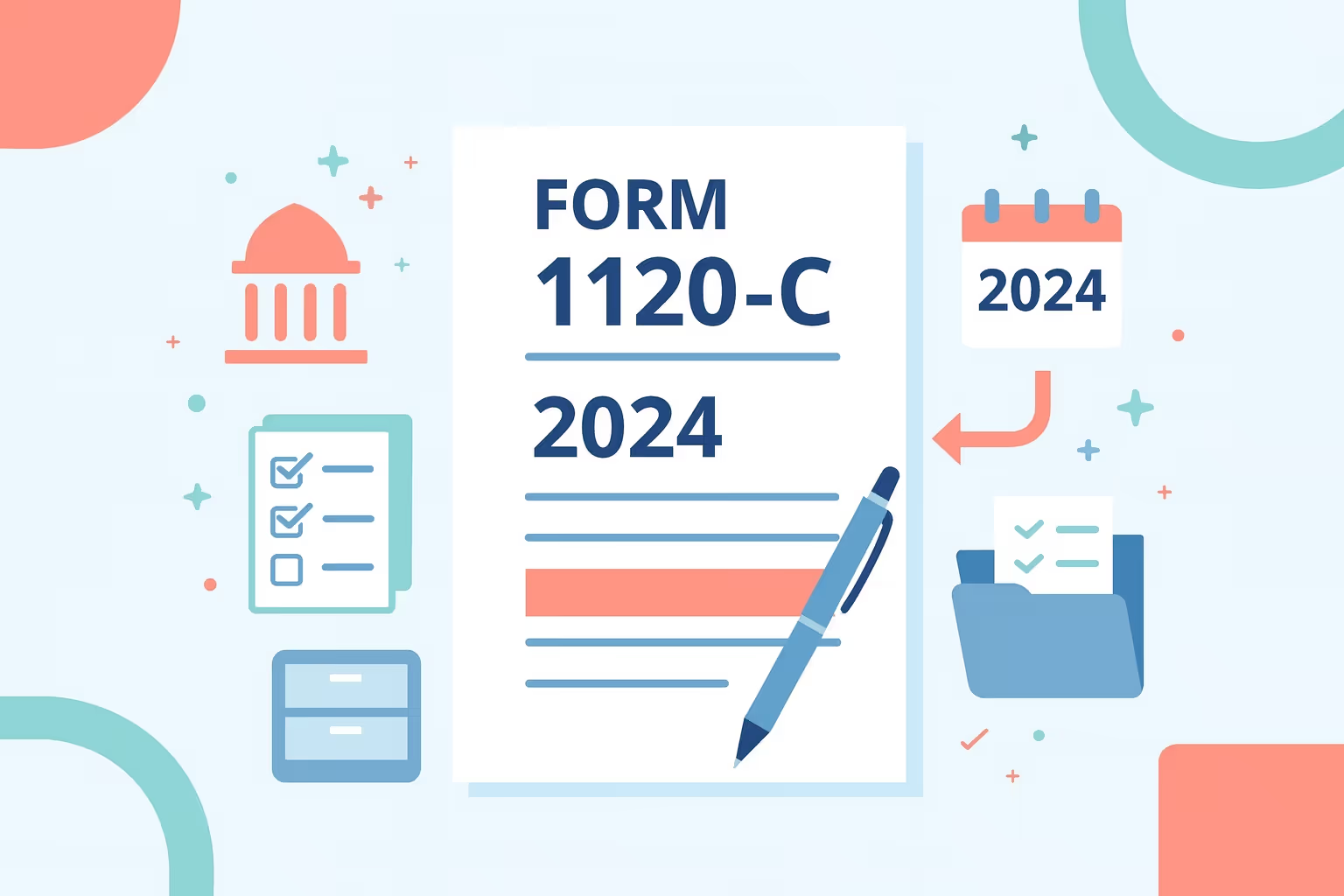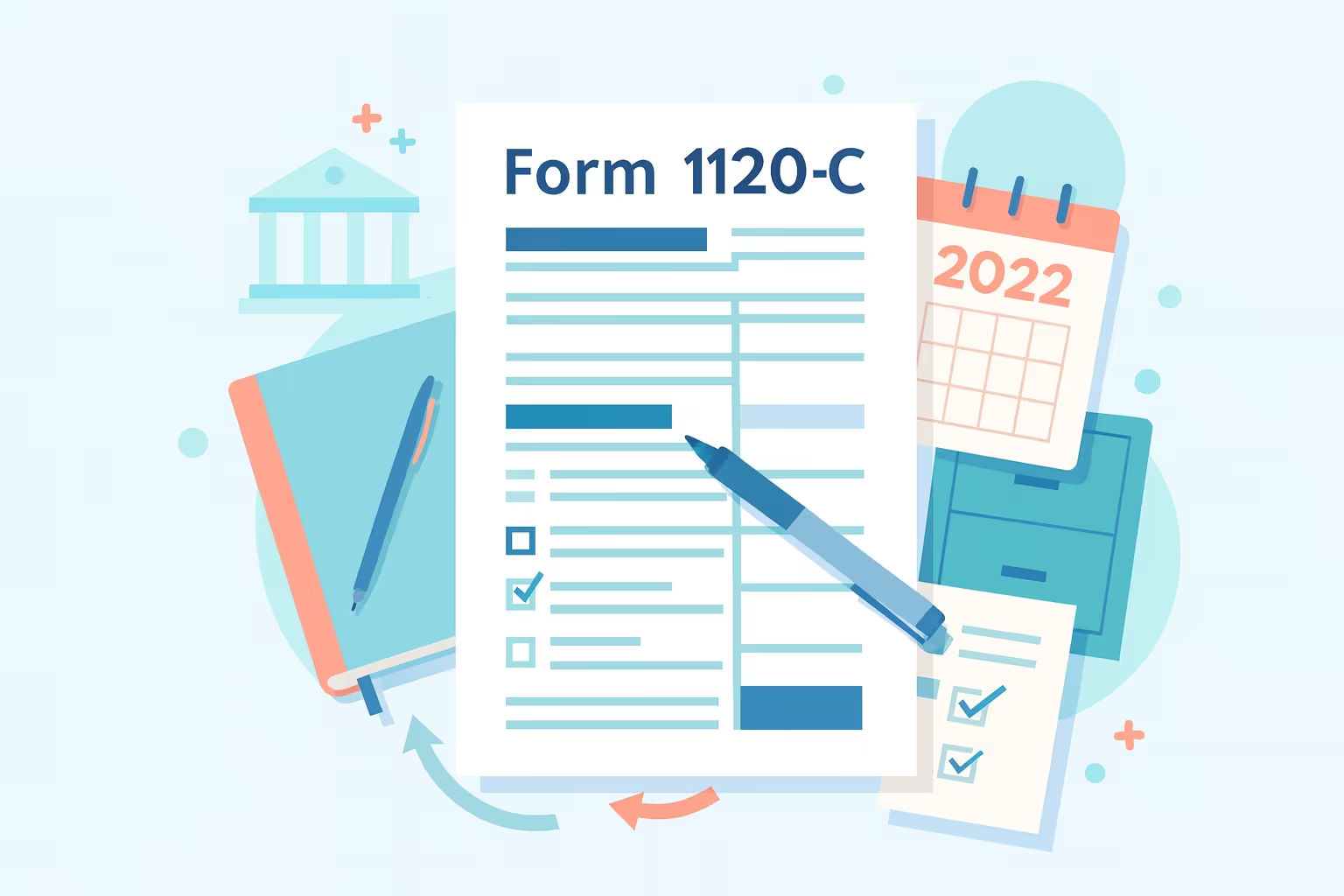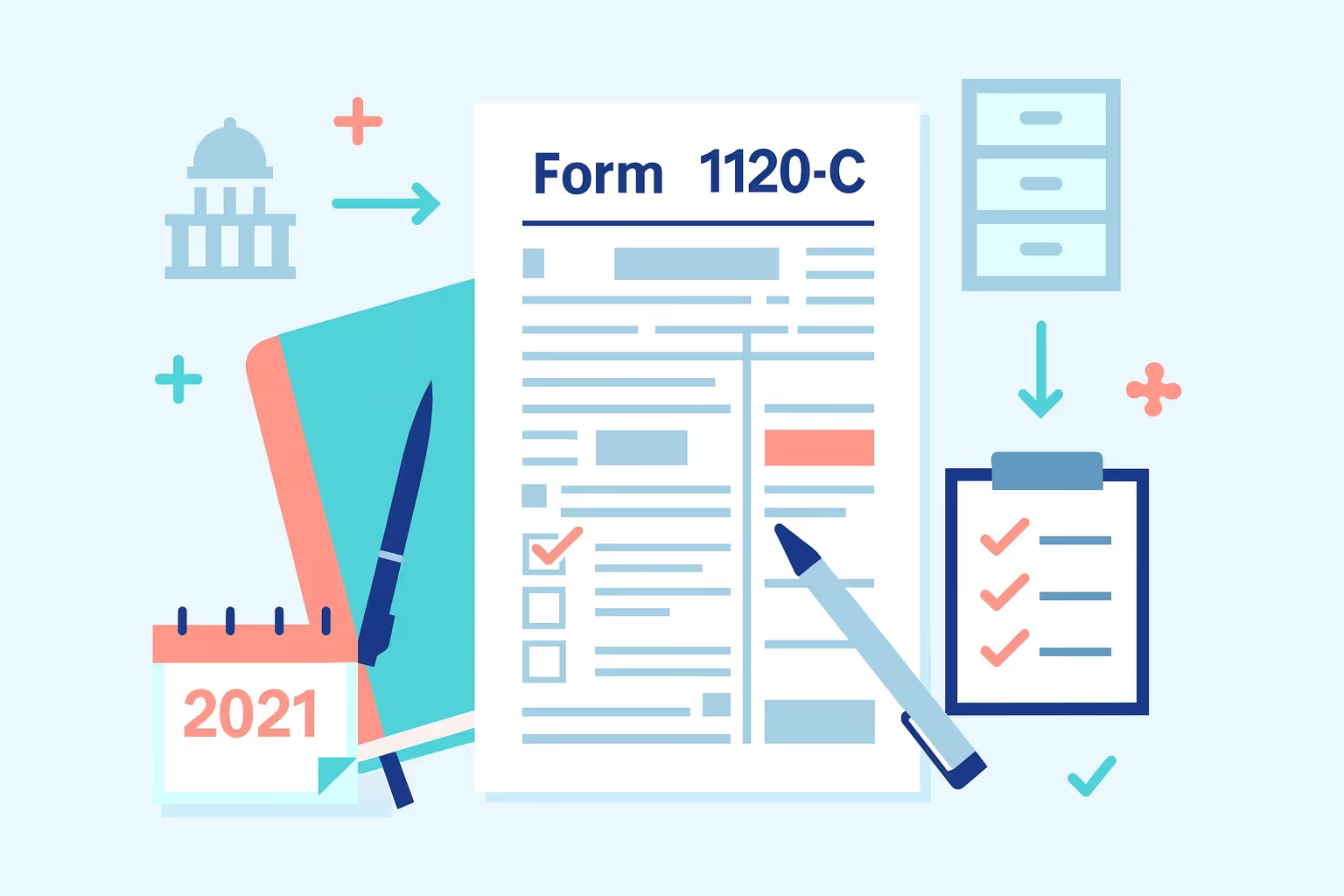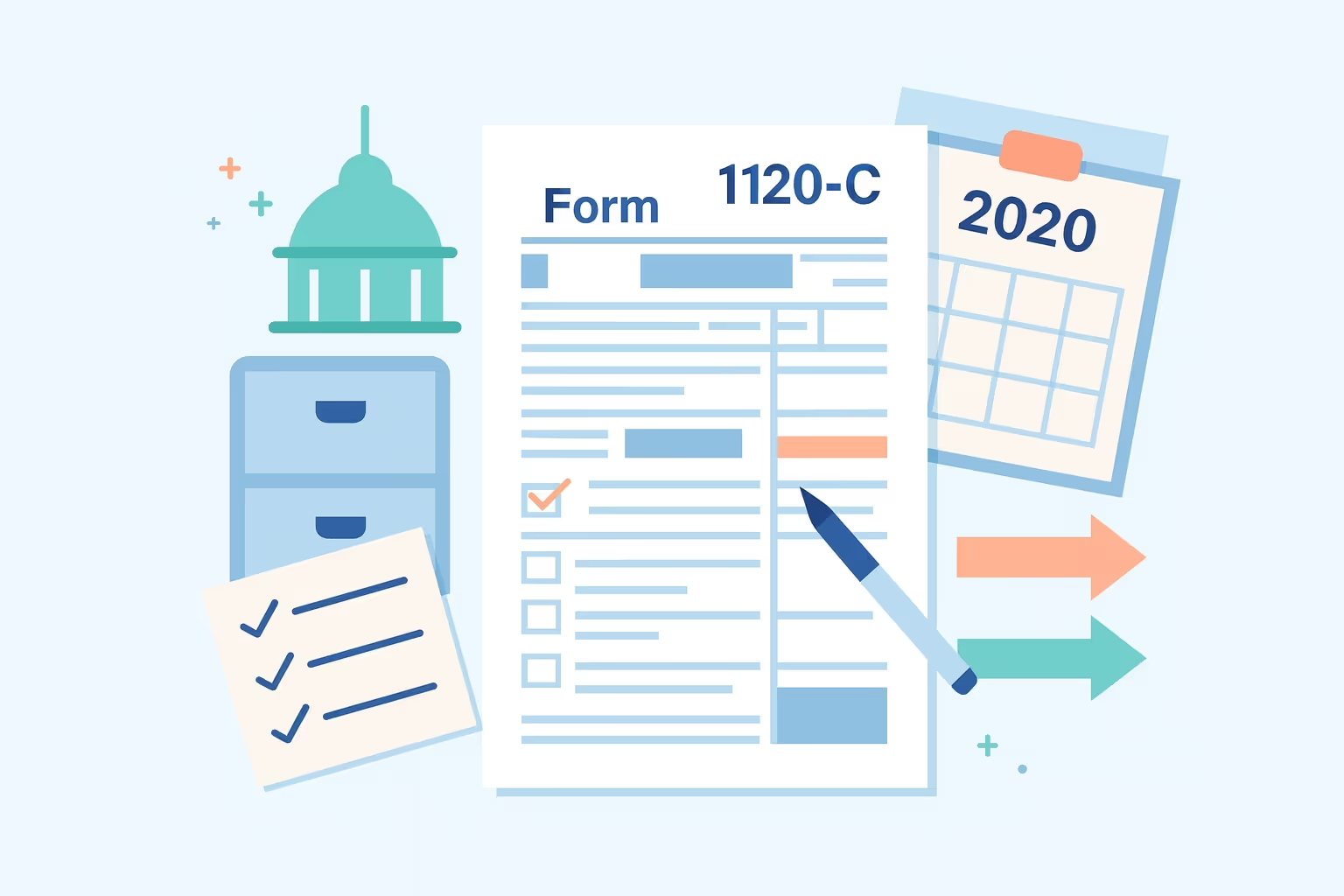
Form 1120-C is the official income tax return for cooperative associations that are member-owned and operate under Subchapter T of the Internal Revenue Code. These organizations include credit unions, marketing cooperatives, and utility cooperatives that allocate earnings based on business conducted with members. Each corporation must report income, deductions, and credits accurately to determine its income tax liability for the 2010 tax year. This guidance applies only to 2010 filings and simplifies requirements for readers managing historical returns.
Accurate completion of the form requires understanding qualified written notices, patronage dividends, and the portion of income subject to federal taxation. Cooperative associations must follow specific instructions outlined by the Internal Revenue Service to ensure every entry, allocation, and exemption adheres to established regulations. Properly documenting amounts strengthens compliance and prevents reporting errors or incomplete statements.
Cooperatives must identify taxable activities, including marketing transactions, property sales, and income from non-member activities, and maintain detailed records for each recipient. According to the IRS official page for Form 1120-C, filers can access archived versions of the form, instructions, and regulatory updates necessary to complete accurate submissions for the 2010 tax year.
Understanding Cooperative Associations and Patronage Income
Cooperative associations operate as member-owned organizations that conduct business to benefit their participants rather than outside investors. These corporations follow the framework outlined in Subchapter T of the Internal Revenue Code, which governs how they calculate taxable income and distribute profits. Each cooperative must determine whether its earnings qualify as patronage or non-patronage income, since classification directly affects income tax liability and eligibility for deductions under Subchapter T regulations.
Definition and Structure
- Cooperative Associations: Corporations organized to provide services, marketing, or goods for their members. Their operations are built on collective ownership and democratic control, with returns distributed based on participation rather than investment.
- Member Ownership: Each participant owns a portion of the organization and contributes capital, ensuring that economic benefits remain with those who use the cooperative’s services.
- Subchapter T Corporations: Entities subject to taxation on income not distributed to members. They must maintain accurate records and comply with regulations specific to cooperative accounting and reporting.
Patronage Dividends
- Purpose and Nature: Patronage dividends represent amounts allocated to members based on their business activity. They reduce taxable income when supported through qualified written notices and detailed accounting.
- Documentation Requirements: Cooperatives must issue statements that outline distributions, recipients, and amounts applied to each member. These records demonstrate compliance and support any deduction claimed on the income tax return.
- Application Rules: Allocations must relate to member transactions, ensuring that dividends reflect genuine patronage activity and not capital-based returns.
Types of Cooperatives
- Credit Unions: Financial cooperatives offering savings and loan services. Many qualify for special exemptions under separate sections of the Internal Revenue Code.
- Marketing Cooperatives: Entities organized to sell member products collectively, improving pricing and market access while maintaining equitable revenue distribution.
- Utility Cooperatives: Providers of energy, water, or telecommunications services to members, often operating in rural areas with tailored taxation considerations.
Understanding these cooperative structures helps determine the proper classification of income and deductions for tax purposes. Each organization must apply the correct tax treatment for patronage income, maintain documentation supporting qualified written notices, and follow published regulations under Subchapter T. Accurate reporting establishes compliance and strengthens financial accountability for all member-owned corporations.
Filing Requirements and Eligibility Criteria
Cooperative associations that operate under Subchapter T of the Internal Revenue Code must determine their filing obligations before preparing an income tax return. These organizations function as member-owned corporations, distributing earnings based on patronage and reporting transactions in compliance with published regulations. Establishing eligibility ensures the cooperative applies correct tax treatments, claims available exemptions, and accurately calculates its income tax liability for the 2010 tax year.
Who Must File
Any corporation operating on a cooperative basis under Internal Revenue Code Section 1381 must submit Form 1120-C for the applicable year. This requirement also applies to marketing, credit, and utility cooperatives allocating amounts to members based on patronage transactions. Entities engaged in both member and non-member business must include all income subject to taxation, identifying which portions qualify for deductions. Filing demonstrates compliance with federal regulations and ensures transparency in how each cooperative applies Subchapter T provisions.
Who Is Exempt
Some organizations conducting similar activities are exempt from filing Form 1120-C. These include credit unions governed under separate provisions of the Internal Revenue Code, insurance corporations subject to Subchapter L, and mutual savings institutions regulated under Subchapter H. Rural utility associations that provide essential services may qualify for exemptions if they meet the criteria set under designated sections of the Internal Revenue Code. Each entity should review organizational documents, governing regulations, and tax classification before confirming its filing obligation.
Filing Deadlines and Documentation
For the 2010 tax year, the filing deadline fell on the fifteenth day of the third month after the cooperative’s fiscal year-end, typically March 15 for calendar-year filers. If the due date coincided with a weekend or federal holiday, the return was due the next business day. Each cooperative must include accurate statements detailing income, deductions, and allocations supported through qualified written notices. Proper documentation confirms that each amount reported aligns with transactions recorded throughout the year.
Key Considerations
Before completing the form, cooperative officers should verify eligibility under Subchapter T, assemble supporting records, and confirm correct patronage and non-patronage income classifications. Maintaining transparency across all reported figures strengthens compliance and demonstrates responsible governance. Evaluating entity type, revenue sources, and exemptions enables cooperatives to apply the correct filing approach and meet federal tax obligations.
Patronage vs. Non-Patronage Income and Tax Implications
Cooperative associations filing under Subchapter T of the Internal Revenue Code must accurately classify their income to ensure compliance and apply the correct tax treatment. Each type of income carries distinct implications for determining income tax liability, applying deductions, and maintaining qualified written notices.
Patronage income represents earnings connected to transactions conducted with or for members through marketing, production, or service-related activities. When cooperatives distribute these amounts as patronage dividends supported by written notices, they may reduce taxable income while maintaining accurate statements that verify allocations and document each recipient’s portion.
Non-patronage income arises from activities outside the cooperative relationship, including transactions with non-members, investment income, or sales of property unrelated to member operations. Cooperatives must treat such income as fully taxable under corporate rules without offsetting it through patronage-based deductions.
Cooperatives must classify these revenues separately, applying consistent accounting practices and adhering to Subchapter T provisions to prevent misreporting. Properly distinguishing between these categories strengthens compliance, preserves exemption eligibility, and ensures that the income tax return accurately reflects the organization’s financial activities.
Patronage Income vs. Non-Patronage Income
Source of Earnings
- Patronage Income: Derived from transactions conducted with or for members under cooperative agreements.
- Non-Patronage Income: Comes from activities unrelated to member transactions, such as investments or sales to non-members.
Tax Treatment
- Patronage Income: Eligible for deductions when distributed as patronage dividends, provided they are supported by qualified written notices.
- Non-Patronage Income: Fully taxable under corporate income rules and not eligible for cooperative deductions.
Documentation Required
- Patronage Income: Requires detailed statements listing recipients, allocated amounts, and qualifying activities.
- Non-Patronage Income: Must include records identifying the income source and nature of transactions to confirm classification.
Impact on the Income Tax Return
- Patronage Income: Reduces taxable income when properly recorded and distributed.
- Non-Patronage Income: Increases taxable income and is reported as ordinary corporate revenue.
Regulatory Framework
- Patronage Income: Governed under Subchapter T of the Internal Revenue Code.
- Non-Patronage Income: Subject to general corporate tax provisions.
Maintaining accurate income classifications safeguards transparency and compliance with federal requirements. By identifying the source of each amount, confirming documentation, and applying appropriate deductions, cooperatives demonstrate adherence to tax regulations and strengthen overall financial accountability. Establishing these distinctions also provides a clear audit trail that supports future filings and reinforces responsible tax reporting practices.
Step-by-Step Guide to Completing Form 1120-C 2010
Completing Form 1120-C for the 2010 tax year requires accuracy, documentation, and adherence to the Internal Revenue Code under Subchapter T. Cooperatives must classify income accurately, document qualified written notices, and verify exemption eligibility before filing the income tax return. The following steps outline the sequence of tasks necessary to prepare, calculate, and finalize the form while ensuring that every section meets federal reporting requirements.
Step 1 – Verify Entity Information
Confirm that the corporation is member-owned and operates on a cooperative basis. Ensure the legal name, Employer Identification Number (EIN), and business address match federal registration records. Identify whether the cooperative qualifies under Subchapter T and confirm its tax year aligns with the 2010 reporting period.
Step 2 – Complete the Header Section
Enter the tax year ending date, type of return, and any special indicators such as “initial,” “final,” or “amended.” Provide accurate entity details, including the principal business address and EIN. Check the appropriate boxes to identify the cooperative type, such as marketing, utility, or credit union, operating under the applicable sections.
Step 3 – Report Gross Income
List total gross receipts, cost of goods sold, and additional revenues generated from cooperative operations. Include marketing income, interest earnings, and sales of other property when applicable. Ensure that each income item is accurately classified as either patronage or non-patronage and supported by detailed statements.
Step 4 – Deduct Allowable Expenses
Record ordinary and necessary business expenses directly related to cooperative operations. These include compensation, wages, rents, depreciation, and administrative costs. Maintain supporting documentation for every deduction to demonstrate compliance with IRS requirements and to verify that each expense portion corresponds to cooperative activity.
Step 5 – Apply Subchapter T Adjustments
Calculate deductions for patronage dividends and qualified written notices allocated to members. Record each adjustment precisely to reflect business done with members. Ensure distributions align with patronage activity and comply with timing and documentation requirements for deduction eligibility.
Step 6 – Determine Income Tax Liability
Use Schedule J to calculate the final tax amount owed. Include any credits, prepayments, or withholdings applicable to the reporting period. Confirm that the figure represents total taxable income after allowable deductions and Subchapter T allocations.
Step 7 – Attach Required Schedules
Attach schedules in the proper IRS order, including Schedules A, C, E, H, K, and L. Each schedule must include statements labeled with the cooperative’s name, EIN, and line references. Review attachments to ensure all amounts reconcile with the primary return entries.
Step 8 – Review and Sign the Return
Conduct a final review of each section, verifying figures, attachments, and supporting statements. The president, treasurer, or chief accounting officer must sign and date the return. Retain copies for corporate records and audit purposes for no less than three years.
Completing each step methodically ensures accuracy, compliance, and proper representation of cooperative operations for the 2010 tax year. Structured reporting also supports transparency and reduces the risk of processing delays or future adjustments. Consistent attention to each detail strengthens organizational accountability and prepares the cooperative for any future regulatory reviews.
Reporting Per-Unit Retain Allocations and Capital Gains
Per-unit retain allocations and capital gains have a significant impact on how cooperative associations report income under Subchapter T of the Internal Revenue Code. These items represent specific transactions tied to patronage and non-patronage activities that influence the cooperative’s overall income tax liability. Proper classification, documentation, and disclosure ensure that every amount distributed or retained is accurately reflected on the income tax return and supported with written records.
- Definition and Purpose: Per-unit retain allocations represent amounts retained from transactions conducted with members, usually based on the volume or value of products handled. These retain act as deferred payments, either in cash or other property, and affect both cooperative equity and tax treatment.
- Qualified and Nonqualified Retains: Qualified per-unit retains are deductible in the year issued, provided qualified written notices support them. Nonqualified retainers become deductible in the year they are redeemed, making timely recognition essential for accurate income reporting.
- Capital Gains Reporting: Cooperatives must report gains or losses from the sale or exchange of other property, including assets used in member transactions. The classification of these gains as patronage or non-patronage determines whether they qualify for deductions or remain fully taxable.
- Documentation Requirements: Each allocation must be supported by detailed statements that list recipients, transaction amounts, and the basis for computation. Records should demonstrate that allocations comply with cooperative policies and are applied equitably among members.
- Regulatory Compliance: Properly applying Subchapter T rules ensures that per-unit retained earnings and capital gains align with federal tax regulations. Each transaction must be analyzed to confirm it meets qualification standards before deductions or credits are applied.
- Recordkeeping Obligations: Maintain complete records of issued retains, redeemed amounts, and related documentation for a minimum of three years. Keeping organized records helps verify deductions during an audit and ensures continuity in future reporting periods.
- Reporting Accuracy: The cooperative must reconcile all retain allocations and capital gains with its income tax return totals. Each reported amount should reflect actual business activity, supported by accurate computations and verified data.
Correct reporting of per-unit retain allocations and capital gains supports compliance, enhances transparency, and strengthens the cooperative’s financial accountability. Accurate classification also promotes consistency across reporting periods and reduces the risk of disputes during regulatory review.
Preparing Documents, Filing the Return, and Paying Taxes
Preparing and submitting Form 1120-C for the 2010 tax year requires complete documentation, accurate calculations, and careful attention to deadlines. Each cooperative association must assemble records that support reported income, deductions, and qualified written notices.
Proper organization ensures that each portion of income, whether from patronage or non-patronage activities, is supported with verifiable statements. Maintaining a detailed file also provides evidence for the Internal Revenue Service in case of future inquiries or audits.
Gather all relevant financial and administrative materials before beginning the filing process. These documents provide the foundation for accurate reporting and proper application of Subchapter T rules.
- Essential Records: Include income statements, balance sheets, general ledgers, prior-year tax returns, and schedules showing allocations, expenses, and capital transactions.
- Patronage Documentation: Include records demonstrating member activity, supporting statements, and qualified written notices.
- Supporting Schedules: Attach Schedules A, C, E, H, K, and L in the correct order to document the cost of goods sold, dividends, compensation, and balance sheet data.
- Verification Materials: Include copies of state filings, meeting minutes approving distributions, and accounting reconciliations confirming reported amounts.
When filing, cooperatives must select the appropriate delivery method based on location and eligibility. For 2010, most associations submitted paper filings, while specific organizations used electronic systems.
- Domestic Filers: Send returns to the Department of the Treasury, Internal Revenue Service Center in Ogden, Utah.
- Foreign Filers: Mail returns to the IRS Service Center, P.O. Box 409101, Ogden, Utah 84409.
- Private Delivery Services: Only designated express options such as UPS Next Day Air and FedEx Priority Overnight qualify as timely filings under IRS guidelines.
Organizations requiring more time may request an automatic extension through IRS Form 7004. This application extends the filing period by six months, though any balance owed remains due by the original deadline. Beginning January 1, 2011, federal tax deposits transitioned to electronic submission, with the Electronic Federal Tax Payment System serving as the standard platform for remitting payments.
- Payment Options:
- EFTPS Enrollment: Register to submit electronic tax payments directly from a designated bank account.
- Third-Party Authorization: Allow authorized financial institutions or payroll services to transmit payments on behalf of the user.
- Same-Day Wire Transfers: Schedule immediate transfers when meeting urgent payment obligations.
- EFTPS Enrollment: Register to submit electronic tax payments directly from a designated bank account.
Meeting documentation, filing, and payment requirements ensures compliance and minimizes processing delays. A well-prepared return reflects responsible governance and reinforces the cooperative’s adherence to the Internal Revenue Code. Accurate submission also supports future reporting consistency and strengthens overall financial transparency.
Maintaining Compliance and Preparing for IRS Review
Ongoing compliance with the Internal Revenue Code is essential for cooperative associations filing under Subchapter T. Each organization must maintain accurate records, apply the correct accounting methods, and document all transactions that support the reported income and deductions. Adhering to federal requirements prevents disputes, ensures precise reporting, and strengthens credibility during an IRS review.
Record Retention Requirements
Cooperatives must preserve all records that substantiate items reported on the income tax return, including statements, receipts, and qualified written notices. Financial documents, meeting minutes, and correspondence related to allocations or distributions should remain accessible for at least three years. If the cooperative carries forward losses or credits, records supporting those amounts must be retained until the items expire. Consistent documentation across reporting periods confirms transparency and allows auditors to verify compliance efficiently.
Common Audit Triggers
IRS examinations often arise from inconsistencies between reported income and supporting records. Frequent triggers include misclassified patronage dividends, missing or incomplete statements, and discrepancies between filed schedules and underlying financial data. Mathematical errors, duplicate deductions, or unreported non-patronage income can also prompt review. Proactively reconciling all entries and verifying that reported amounts match supporting documentation reduces the likelihood of an audit.
Preparation Strategies
Cooperatives should maintain a clear and organized filing system to support every entry on the tax return. Each deduction must correspond to a verifiable business expense, and every allocation must match member activity records. Consistent accounting methods and periodic internal reviews identify irregularities before submission. Designating an officer or qualified tax professional to oversee compliance procedures further enhances accuracy and readiness.
Professional Guidance
Organizations handling detailed reporting under Subchapter T or unique cooperative transactions may benefit from specialized tax guidance. Professionals with cooperative taxation experience can review allocations, verify Subchapter T compliance, and assist in preparing audit-ready records. Engaging a qualified professional ensures each aspect of the return aligns with IRS regulations while preserving cooperative tax advantages.
Maintaining compliance requires diligence, accuracy, and proactive oversight to ensure adherence to regulations. A cooperative that implements sound recordkeeping and review practices demonstrates strong governance, minimizes risk, and upholds confidence during any future IRS examination. Consistent adherence to proper procedures ensures accuracy in future filings and reduces the likelihood of recurring reporting issues.
Frequently Asked Questions
What is Form 1120-C, and who must file an income tax return?
Form 1120-C is the income tax return required for cooperative associations operating under Subchapter T of the Internal Revenue Code. It applies to corporations owned by patrons that distribute earnings based on cooperative activity. These entities generally include agricultural marketing groups, credit unions, and utility cooperatives. Each filer must classify income correctly and follow specific instructions to report amounts allocated or distributed to members during the tax year.
How are patronage dividends reported and passed through to patrons?
Patronage dividends represent amounts distributed or credited to patrons based on business conducted with the cooperative. These dividends are passed through as part of the cooperative’s ordinary operations and may reduce taxable income when properly documented. Each distribution must include written statements showing amounts allocated, confirming compliance with specific instructions under Subchapter T. Accurate reporting ensures that only qualified transactions receive deduction eligibility on the income tax return.
What are qualified written notices, and how are they issued to patrons?
Qualified written notices are formal documents that specify the amount of patronage dividends or per-unit retains allocated to each member. Cooperatives issue these notices to patrons when distributing earnings, providing a clear record for both reporting and deduction purposes. Accurate statements must support the notices and meet timing requirements established in Subchapter T. Issuing them correctly allows cooperatives to claim deductions and maintain compliance with federal reporting standards.
What types of income are generally classified as non-patronage income?
Non-patronage income includes revenue earned from activities unrelated to member transactions, such as investments, rental income, or sales to non-members. These amounts are taxable under corporate income tax rules and cannot be offset through patronage-based deductions. Proper classification ensures accuracy in determining the cooperative’s final tax liability. Each organization must distinguish these earnings from patronage activity to comply with the specific instructions in Subchapter T reporting requirements.
How are per-unit retain allocations recorded on the income tax return?
Per-unit retain allocations represent the amounts retained from member transactions, often based on the volume or value of business conducted. Cooperatives record these allocations on the income tax return as deferred payments or equity contributions, depending on whether they are qualified or nonqualified. Each allocation must follow IRS requirements, include detailed statements, and correspond to actual transactions with patrons. Correct categorization ensures compliance and supports accurate deduction claims under cooperative tax regulations.
Can cooperatives make electronic payments for tax liabilities?
Yes, cooperatives may use the Electronic Federal Tax Payment System (EFTPS) to submit tax payments securely online. EFTPS enables the scheduling of deposits, tracking of payment history, and confirmation of timely submissions. This method ensures accuracy and compliance with IRS payment requirements. Additionally, cooperatives can authorize third-party providers or financial institutions to transmit payments. Electronic submission supports transparency, reduces errors, and provides immediate confirmation of completed transfers associated with Form 1120-C filings.
What additional steps support accurate reporting and compliance?
Cooperatives enhance accuracy through consistent record-keeping, internal reviews, and adherence to specific guidelines for income classification and reporting. Reviewing allocations, verifying supporting documentation, and reconciling totals passed through to patrons helps ensure full compliance with regulations. Additionally, maintaining detailed statements and confirming all figures align with Subchapter T requirements supports transparency during review. These steps collectively uphold reporting integrity, reduce risks of adjustment, and demonstrate a cooperative’s commitment to responsible financial governance.
























